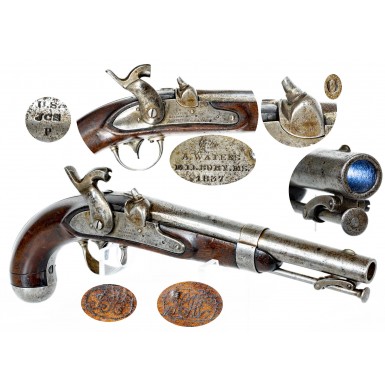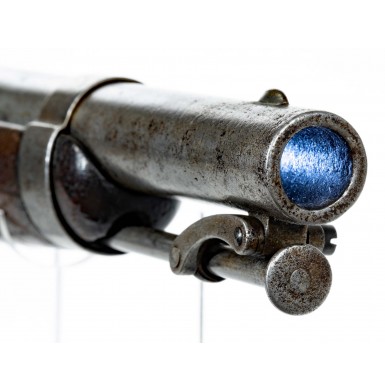Confederate Brazed Bolster Altered US M1836 Pistol - Likely by D.C. Hodgkins of Macon
- Product Code: FHG-2178-SOLD
- Availability: In Stock
-
$1.00
Determining the identity of the gunsmith or arsenal that performed Confederate percussion alterations to small arms can be difficult at best and is sometimes nearly impossible. While certain features and styles of work can sometimes be directly documented to a specific gunsmith or arsenal, very often we are left with only the best “guess work”, based upon reasonable research and circumstantial evidence to attribute a certain style of alteration to a specific time and place. To date, the very best work done along those lines is the seminal text Confederate Rifles & Muskets by the late Dr. John Murphy and Howard Michael Madaus. Using original documents, extant examples and a high level of scholarship, they managed to identify (or at least “attribute”) a large number of alteration types to various southern gunsmiths and arsenals. As the work of these arsenals and artisans is rarely marked, the research was no doubt a Herculean effort, and is of course open to additional research and newly found information. Still, their work is the absolute best available on the subject and is always my first stop when trying to identify a clearly Confederate alteration of a flintlock arm to percussion.
I recently obtained a unique US Model 1836 Flintlock Pistol, altered to percussion. The style of the brazed bolster and the obviously filled drill path in the bolster for the new flash channel left no doubt that the gun had been altered in the South, but identification remained somewhat elusive. The crude, hand-cut checkering of the hammer spur was also a clear southern trait. Unfortunately, there is no good reference regarding Southern altered pistols, so the next best source is Confederate Rifles & Muskets. I spent a significant amount of time in the book in hopes of identifying the bolster shape, hammer, mating codes, etc. By using this reference, I determined that the pistol’s bolster style was most like the altered rifles and muskets attributed D.C. Hodgkins of Macon, GA. However, only a minimal amount of evidence indicates that D.C. Hodgkins ever altered any pistols, with most of the records relating to the alteration of flintlock rifle and muskets. However, one period reference does note that the firm had “manufactured for the State of Georgia over $100,000 work of munitions of War and altered over 2,000 of the old flint and steel muskets into good percussion locks.” Murphy and Madaus follow this quote by noting that based upon their work they felt that the “2,000 flint and steel” arms were a mix of muskets, rifles and pistols.
The firm of Daniel C. Hodgkins and Sons were an antebellum era firearms and sporting goods retailer and manufacturer located in Macon, GA. Their letterhead referred to the firm as “Dealers & Manufacturers of Guns, Sporting Articles & c.” and gave their address as Mulberry Street in Macon. Their pre-war business of dealing in a wide variety of sporting arms meant that the company had contacts in the industrial North that allowed them to obtain firearms from northern manufacturers. During 1860, the firm sold a large number of rifle and muskets to the state of Georgia in preparation for the coming Civil War, as well as a variety of accouterments and sabers. The largest consignment of arms delivered by Hodgkins, and one to receive the most publicity, was an order of Enfield Rifle muskets that were seized by the New York Police on January 22, 1861. These “Enfields” were actually Robbins & Lawrence produced, “Windsor” marked, Type II Pattern 1853 Enfield Rifle Muskets that had intended to be part of a British government order from the Crimean War. Ten cases of twenty muskets (200 total) were a consignment for Hodgkins, which were to be delivered to the State of Georgia. The guns would subsequently be released, as hostilities had not yet erupted, but it clearly shows how involved the firm was with procuring and channeling arms to the south immediately prior to the war.
The pistol offered here is a brazed bolster percussion conversion of a US Model 1836 Flintlock Pistol that appears to have been altered by D.C. Hodgkins, based upon the shape of the bolster. The .54 caliber, smoothbore single shot pistol was originally produced by Asa Waters of Milbury, MA in 1837. The pistol is in about GOOD condition, especially for an early war Confederate alteration.
The pistol is marked in four lines on the lock plate:
{Eagle Head}
A. WATERS
MILBURY, MS
1837
The markings remain quite clear and legible. Waters delivered some 20,000 of the pistols between 1837 and 1843, with an additional 3,000 delivered in 1844. The Model 1836 was the standard US pistol during the Mexican-American War (it is doubtful many, if any Model 1842 percussion pistols saw use there) and was a pistol that was provided to the states in huge quantities under the Militia Act of 1808, especially after the percussion system was adopted. The gun retains the original breech markings of U.S. / JCS / P. The “JCS” inspection mark is that of US arsenal sub-inspector John C. Stebbins. The counterpane of the stock retains two legible script cartouches, the forward one the JH of arsenal sub-inspector Joseph Hannis and the rearward one being the HCK of accepting US ordnance officer Henry Craig Knox. A variety of small sub-inspection marks are found throughout the pistol, primarily the small “H” of Joseph Hannis.
The pistol has been altered from flintlock to percussion by removing all of the external flintlock battery and filling the unused screw holes. A fenced bolster with a rounded bottom that rests in the old flintlock pan recess has been brazed into place over the original flintlock vent hole. The touchhole path was drilled through the newly applied bolster and then the outer section was filled with a screw that was then filed flat, leaving a clear round seam on the outer edge of the bolster. This same feature is found on many of the brazed bolster alterations by southern arsenals and gunsmiths, like those of Thomas J. Adams and S.C. Robinson of Richmond and the Florence, NC armory, just to name a few. A percussion hammer with crudely cut checkering on the hammer spur was added and both the bolster and hammer are mating marked with a 0 on their exterior surfaces. This mark is also present on the necks of the lock screws. Some traces of old brazing material is found under the bolster, where it is concealed by the stock. The pistol has been marked with the reassembly code of 3 punch dots inside the lock plate, under the barrel and in the barrel channel of the stock. This type of punch dot marking has been encountered on Hodgkins altered long arms, and both alpha and numeric mating codes have been encountered on the various percussion parts as well.
The lock functions crisply and correctly on all positions and is mechanically excellent. The skirt of the hammer nose show a chip of missing metal on the inner side. The metal of the pistol has been cleaned at some point in time, leaving it a medium gunmetal color, with some scattered areas of minor age discoloration. The metal is evenly pitted throughout on the barrel and furniture, with the breech showing the most notable pitting. Only the lock has escaped any serious pitting. Some scattered areas of oxidized surface roughness and darker discoloration are scattered here and there on the pistol. The original swivel ramrod is in place and functions correctly. The bore of the pistol is in about GOOD condition with even moderate pitting along its entire length. The pistol retains the original brass blade front sight and the notched rear sight on the breech. The stock of the pistol has been lightly cleaned in the past and may have been very lightly sanded as well. The edges of the wood are softened, and the cartouches are slightly light, although they remain quite legible. The stock shows wear commensurate with the condition of the metal and typical of a gun that likely saw significant early war Confederate service. There is a crack through the grip about ½” above the butt cap, as well as a couple of tight grain cracks in the counterpane, one running from the front lock screw to the barrel channel and the running back from the rear lock screw towards the wrist for about 1 ½”. Otherwise, the stock shows the expected scattered bumps, dings and wear marks that any 150+ year old martial pistol, that likely saw service in two major wars, would show.
Overall this is a solid example of a Confederate Brazed Bolster Alteration of a US Model 1836 Pistol. This is perfect example of the type of early war, “make do” weapons that many young Southrons carried off to war in the Spring of 1861. For a collector of Confederate arms this is a great opportunity to add a real Confederate handgun to your collection for the price of a mid-grade US Model 1861 contract rifle musket. While I cannot definitively prove this to be the work of D.C. Hodgkins, it is clearly Confederate and deep south work and stylistically most closely conforms to the arms altered by that firm. This would be a great addition to a display of early war Confederate cavalry items or a collection that centers on Georgia arms, as I am rather confident that this gun was altered for the Confederacy in Macon.
SOLD
Tags: Confederate, Brazed, Bolster, Altered, US, M1836, Pistol, Likely, by, D, C, Hodgkins, of, Macon








